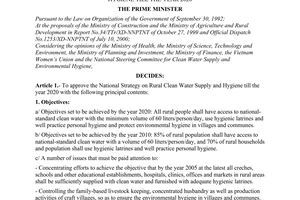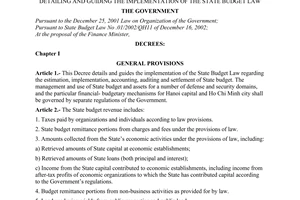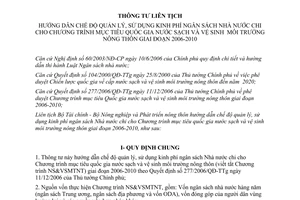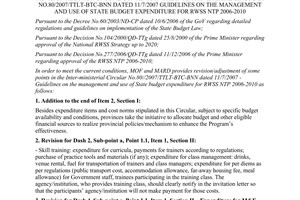Nội dung toàn văn Joint circular No. 80/2007/TTLT-BTC-BNN guidelines on management and use of stat
|
MINISTRY OF AGRICULTURE AND RURAL DEVELOPMENT – MINISTRY OF
FINANCE |
SOCIALIST REPUBLIC OF VIET NAM |
|
Hanoi, July 11, 2007 |
JOINT CIRCULAR
GUIDELINES ON MANAGEMENT AND USE OF STATE BUDGET EXPENDITURE FOR RWSS NTP, PHASE 2006-2010
Pursuant to the Decree no. 60/2003/NĐ-CP dated 10/6/2006 of the GoV regarding detailed regulations and guidelines on implementation of the State Budget Law;
Pursuant to the Decision 104/2000/QĐ-TTg dated 25/8/2000 of the Prime Minister regarding approval of the National RWSS Strategy up to 2020;
Pursuant to the Decision 277/2006/QĐ-TTg dated 11/12/2006 of the Prime Minister regarding approval of the RWSS NTP, phase 2006-2010;
Inter-ministries of MOF and MARD issue the guidelines on management and use of state budget expenditure for RWSS NTP, phase 2006-2010 as follows:
I- GENERAL REGULATION
1. This circular provides guidelines on management and use of state budget expenditure for RWSS NTP, phase 2006-2010 (abbreviated by RWSS NTP), phase 2006-2010 in accordance with the Decision 277/2006/QD-TTg dated 11/12/2006 of the Prime Minister;
2. Funds to implement the RWSS NTP include: annual state budget (central budget, local budget and ODA budget), beneficiaries’ contribution and other eligible resources;
Provincial People’s Committee, People’s Committee of cities under the Central Government (hereafter called PPCs) allocate annual local budget (including ODA budget) for the Program, mainstreaming that with other funding sources available in the localities for better obtaining the Program’s objectives.
3. Investment principles of the RWSS NTP:
- All rural areas of the country; with immediate priority to remote areas, ethnic minority people, coastal areas, draughter, water disadvantaged areas, and water polluted areas.
- The program supports poor households, privileged households, ethnic minority people areas and specially water and environmental disadvantaged rural areas.
- Funds for the Program will be allocated depending on availability of state budget and other resources, according to the approved projects and on a public-private joint contribution basis.
- Relevant ministries, PCs at various levels have to include water supply and hygienic latrines in their decision of newly constructed or rehabilitated public constructions; the state budget within RWSS NTP is not targeted at investments of these constructions.
4. Relevant agencies are obliged to use the RWSS NTP funds effectively following the regulations; under the review and control of appropriate authorities; fund expenditure clearance has to be carried out at the end of year or at project completion in accordance with current regulations.
II. DETAILED REGULATIONS
1. Expenditure purposes and cost-norms of the RWSS NTP:
1.1 Expenditure using operational fund:
a) Expenditure purposes:
- Expenditure for social motivation, including: posting news on mass media such as the central and local radio, television, newspaper and other media; printing and disseminating technical materials, leaflets, posters, films; other expenditure, if any.
- Skill training: Expenditure for curricula, payments for trainers according to regulations; purchase of practice tools and material, if any; expenditure for class management: drinks, venue rental, fuel for transportation of trainers and class managers, food, accommodation and transportation for trainees during training courses according to current regulations.
- Expenditure for applying advanced sciences and technologies in the Program (if any): based on the successful research on RWSS solutions and technologies, the Program will introduce advanced technical application through various modals that fit people’s financial capacity and various local conditions.
- Expenditure for the monitoring and evaluation system of the RWSS NTP;
- Expenditure for developing hygienic latrine modals;
- Expenditure for developing hygienic latrine modals for rural health clinics, schools (kindergartens, nursery schools, primary schools, secondary schools, high schools), rural markets lacking hygienic latrines, environmental polluted areas, specially difficult areas, ethnic minority people areas, mountainous areas, coastal capes and islands, boundary communes according to the regulations of the Prime Minister; Investment support cost-norms using state budget are defined in item (1), point b, article 1.2, Part II of this Circular.
- Expenditure for developing pilot modals for livestock waste treatment;
- Expenditure for supporting operation and maintenance of pipe schemes as technical standards: PPCs will decide to support the O&M for those schemes which are not yet cost-recovery, but this support can not last over 3 years since operation;
- Expenditure for offices, interpreters, drivers that serve international advisers of the Program Standing Office and at ministries, provinces where international specialists base;
- Unexpected expenditure according to decision made by appropriate authority.
b) Cost-norms: Expenditure for the RWSS NTP will follow the current expenditure cost-norms; this circular provides further detailed guidelines on cost-norms as follows:
(1) Expenditure for developing hygienic latrine modals:
- Maximum subsidy from state budget for each commune to apply the modals will be 200 million VND;
- Expenditure for each modal includes:
+ Expenditure for selecting project site, interviewing and data processing;
+ Expenditure for technical instruction staff: Contracted staff: maximum employment rate will be as much as 2.5 times that of minimum salary rate/month (22 days) for direct instruction on the modal; government staff involved will be paid with per diem according to current regulations;
+ Expenditure for social motivation and technical instruction to the people;
+ Expenditure for project inspection and acceptance;
+ Expenditure for part of construction material (steel, cement, brick, sand...) for the people involving the modal, this expenditure will make up minimum 80% of the total cost of the modal in a commune.
The subsidy for each household involving the modal is defined as follows: For poor households and households in specially difficult communes in ethnic minority people areas and mountainous areas, coastal capes and islands, boundary communes, the subsidy from state budget, by regulations of the Prime Minister, can not be higher than 75% of the total construction cost estimate approved by appropriate authority, but the maximum subsidy will be 500,000VND/household; for households in other areas, the maximum subsidy will be 300,000VND/household.
Household selection and subsidy amount for each household will be decided by the PPCs or authorised lower level PCs based on targeted receivers, order of priority but the total subsidy can not exceed the subsidy for a commune.
(2) Expenditure for developing livestock waste treatment modals:
- The maximum subsidy amount from state budget for a commune to perform the modal will be 200 million VND.
- Expenditure for the modal include: the same items as for hygienic latrine modal in Point (1) above.
Subsidy amount from state budget for farmer households involving in the modal is defined as follows:
+ For livestock pens with 10 or fewer animals: the maximum subsidy from state budget will be 400,000 VND/household.
+ For livestock pens with more than 10 animals: the maximum subsidy from state budget will be 600,000 VND/household.
For those having biogas: the subsidy will plus 200,000 VND/household.
For poor households and households in especially difficult communes in ethnic minority people areas and mountainous areas; coastal capes and islands, boundary communes, the subsidy from state budget, by regulations of the Prime Minister, will increase by 20% compared to the above-mentioned normal amount.
For any commune performing a modal that mainstreams hygienic latrine and livestock waste treatment, the maximum subsidy from state budget for the mainstreamed modal will be 200 million VND.
Supported household selection and subsidy amount for each household will be decided by the PPCs or PPCs authorised agencies based on principles and order of priority. The total subsidy can not exceed the subsidy for a commune.
1.2 Expenditure from development investment fund:
a) Expenditure purposes:
- Planning for RWSS of national level, ecological zones, provincial and district levels; according to the projects, investment reports need to be approved by the appropriate authority.
- Expenditure for construction of hygienic latrines, including that of schools (kindergartens, nursery schools, primary schools, secondary schools, high schools), health clinics, rural market, rural public buildings, and CPC offices.
- Expenditure for construction of water supply schemes, including for schools (kindergartens, nursery schools, primary schools, secondary schools, high schools, rural vocational schools), health clinics, markets, rural public buildings, border posts and boundary residential areas, CPC offices.
- Expenditure to support development of trade village waste treatment modals;
- Expenditure for advanced science and technology application in the Program: Based on successful research on RWSS solutions and technologies that have been tested through modal piloting, the Program will expand those modals in other areas.
b) Cost-norms:
(1) Hygienic latrines:
- Household hygienic latrines: Proportion and amount of subsidy is defined at item (1) point b article 1.1, Part II.
- For hygienic latrines for health clinics, schools (kindergartens, nursery schools, primary schools, secondary schools, high schools), rural markets: subsidy from state budget can not exceed 75% total cost estimate of the approved construction; for non-revenue institutes: PPCs will consider and decide an appropriate investment amount using state budget.
(2) Clean water supply facilities:
- Pipe water schemes: The subsidy from state budget is to support partly the cost of steel, cement, bricks, sand and equipments for primary constructions, water treatment plants, and main pipelines. The subsidy amounts are defined as follows:
+ For pipe water schemes: the subsidy from state budget:
* can not exceed 45% of the total cost estimate of the approved construction, applying for the lowland, small towns, and coastal areas.
* can not exceed 90% the total cost estimate of the approved construction, applying for the specially difficult communes in ethnic minority people areas and mountainous areas, coastal capes and islands, boundary communes, by the regulations of the Prime Minister; for cases where the Prime Minister has decided to support water supply schemes using state budget: source of funding and amount of investment support are subject to the decision of the Prime Minister;
* can not exceed 60% of the total cost estimate of the approved construction, applying for other rural areas;
* For water supply facilities in health clinics, schools (kindergartens, nursery schools, primary schools, secondary schools, high schools, rural vocational schools), rural markets, subsidy from state budget can not exceed 75% of the total cost estimate of the approved construction; for non-revenue institutes: PPCs will consider and decide an appropriate investment amount using state budget.
+ Gravity water supply facilities (only in highland areas): subsidy from state budget can not exceed 90% of the total cost estimate of the approved constructions.
Based on the above mentioned subsidy amounts, relevant ministries, PPCs will decide specific subsidy amounts for projects at inter-villages (inter-hamlets) level, commune level, and implement the projects in accordance with annual allocated funds.
- Individual water supply facilities: subsidy from state budget will support partly construction material such as: pipe, hand drilling, cement, rain water gutter depending on types of water supply facilities for poor households, social privileged households, and households in specially difficult communes in ethnic minority people areas and mountainous areas, coastal capes and islands, boundary communes by the regulations of the Prime Minister; for cases where the Prime Minister has decided to support investment of individual water supply facilities, funding sources and support amounts will be provided according to the decision of the Prime Minister.
- Specific subsidy amounts:
+ Small diameter tube well: the maximum subsidy from state budget will be 600,000 VND/household.
+ Dug well: the maximum subsidy from state budget will be 400,000 VND/household.
+ Rain water tank (4m3): the maximum subsidy from state budget will be 600,000 VND/household; rain water jar (2m3): the maximum subsidy from state budget will be 400,000 VND/household (for water difficult and scattered areas).
Particularly for households of Vietnamese heroic mothers, households having martyrs, households deserving credit for the Revolution: subsidy from state budget will be 100% of the total cost of the approved construction; for households of the disable, disadvantaged people: the PPCs will consider and decide appropriate support amounts.
(3) Expenditure for developing trade village waste treatment modals: subsidy from state budget will support partly construction material such as cement, bricks, sand for the treatment constructions chain or main drainages and equipments. Specific support amount: subsidy from state budget can not exceed 60% of the total cost estimate of the approved construction;
Based on the above mentioned subsidy amounts, relevant ministries, PPCs will decide specific subsidy amounts for projects at inter-villages (inter-hamlets) level, commune level, and implement the projects in accordance with annual allocated funds.
1.3 Expenditure purposes and amounts will follow the approved project documents for donor supported RWSS projects that clearly define project objectives and sites, funding sources.
2. Planning, performance and clearance of the state budget:
a) The planning, performance and clearance of the state budget for RWSS NTP will follow regulations in the State Budget Law and its secondary guidelines.
Budget for RWSS NTP reflects:
- Task of water supply: Type 21. Item 03, source code 0004 01;
- Task of rural environmental sanitation: Type 21. Item equivalent to source code 0004 02;
b) Additional targeted fund for RWSS NTP will performed according to regulations in Circular 86/2006/TT-BTC dated 18/9/2006 of the MOF concerning guidelines on management of additional targeted fund from central budget to local budget.
III. IMPLEMENTATION STRUCTURE:
1. MARD:
- Annual planning and needs of fund for RWSS NTP based on proposals from ministries, organizations, provinces and cites submitted to MPI and MOF for consolidation and reporting to decision making levels; taking lead in providing the donors with annual work plan and budget of the Program complying with the signed Agreement;
- Take lead and collaborate with MOH, MPI, MOF and TPBS donors (AusAid, Danida, RNE) in evaluation of Program implementation process; consolidate and submit reports to the Prime Minister with copy to MPI, MOF; provide the donors with Program implementation progress reports complying with the signed Agreement;
- Perform auditing as required by the donors.
2. PPCs and PCs of cities under central Government:
- Organize and direct effective implementation of the Program at localities according to guidelines of MARD and relevant ministries and according to local approved plans;
- Mainstream various funding resources of various programs, projects in the localities for efficient implementation of the Program; make decisions on investment projects with precise project list and tasks attached to Decision 277/2006/QĐ-TTg; allocate sufficient funds as responsibility of the localities;
- Mobilize resources (community contribution and other eligible funds), direct implementing agencies to promote contribution of people in beneficiary area in accordance with commitment for investment for construction of RWSS facilities; direct and organize or decentralize planning, appraisal, and approval of projects under the Program as regulations.
- Collaborate with MARD to provide the donors with reports in accordance with the signed Agreement.
3. MPI and MOF based on the contents of the Program, based on proposals of MARD and other relevant ministries, local authorities balance and allocate annual planned budgets in accordance with the State Budget Law for implementation.
4. Relevant central ministries, agencies involving in the Program are responsible for reviewing their direct sub-agencies to perform fully guidelines on financial management and report periodically (quarterly, annual) to MARD (Program Steering Committee), MPI, MOF on work progress and integrate clearance of expenditure of budget for Program implementation as regulations.
5. This Circular will take effect after 15 days from publication in the Official Gazette and replace the Inter-ministerial Circular 66/2003/TTLT/BTC-NN&PTNT of the MOF and MARD concerning guidelines on management, subsidy and clearance of the RWSS NTP funds.
If obstacles occur during implementation, implementing agencies are requested to inform the Inter-ministries for studying adjustments.
|
ON BEHALF OF MARD MINISTER |
ON BEHALF OF MOF MINISTER |



